Page path:
Echinidinium karaense
Zonneveld, K.A.F. and Pospelova V. (2015). A determination key for modern dinoflagellate cysts. Palynology 39 (3), 387- 409.
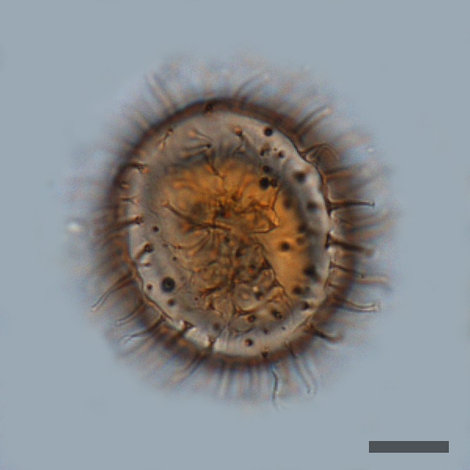
lateral view
photographs: Vera Pospelova
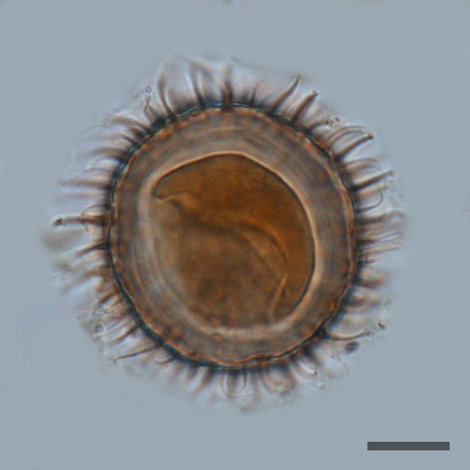
cross section
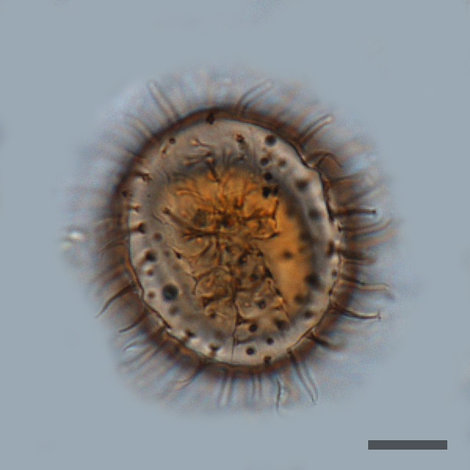
lateral view
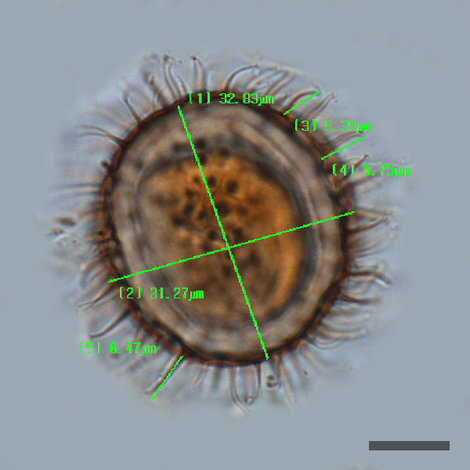
dimensions
Field characteristics
Echinidinium karaense (Head et al., 2001) Radi et al., 2013.
Characteristics:
Brown spherical cyst with smooth cell wall that has numerous irregularly distributed processes of various width and length. Processes are conical to tapering, Apiculocavate with circular basis. Tips are acuminate and/or minutely expanded. Archeopyle is therophylic.
Dimensions: Cyst body diameter: 29 to 36 µm; length of processes: 5 to 7 µm.
Motile affinity: unknown
Stratigraphic range: recent
Comparison with other species:
This species resembles most closely that of Islandinium minutum and Islandinium? cezare in having apiculocavate processes. It differs from both species in having processes of different width and length that can be acuminate or minutely expanded. It does not posses solid processes and it also has a smooth wall surface.
Characteristics:
Brown spherical cyst with smooth cell wall that has numerous irregularly distributed processes of various width and length. Processes are conical to tapering, Apiculocavate with circular basis. Tips are acuminate and/or minutely expanded. Archeopyle is therophylic.
Dimensions: Cyst body diameter: 29 to 36 µm; length of processes: 5 to 7 µm.
Motile affinity: unknown
Stratigraphic range: recent
Comparison with other species:
This species resembles most closely that of Islandinium minutum and Islandinium? cezare in having apiculocavate processes. It differs from both species in having processes of different width and length that can be acuminate or minutely expanded. It does not posses solid processes and it also has a smooth wall surface.
Geographic distribution
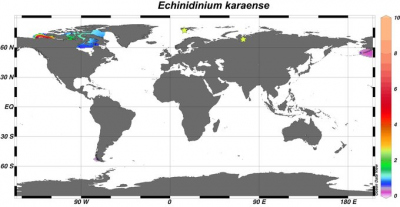
Distribution:
Echinidinium karaense is observed in coastal sites of the Arctic regions of the Beaufort Sea, Baffin Bay, the northwestern Passages and the northern part of the Hudson Bay. In the Beaufort Sea it can form up to 8.5 % of the assemblage.
Environmental parameter range:
SST: -2.0 - 8.6°C (winter - summer), SSS: 20.5-33.8 (spring - summer), [P]: 0.5 - 1.3 μmol/l, [N]: 1.0 - 13.2 μmol/l, chlorophyll-a: 0.25 - 10.9 ml/l, bottom water [O2]: 2.3 - 7.9 ml/l.
The species occurs in a narrow temperature range in eutrophic environments, which may have low spring SSS due to ice melting. Bottom waters are well ventilated.
Comparison with other records:
Apart from the data included in this Atlas the species has been registered from the shallow water of the White Sea (Golovnina and Polyakova, 2004; Novichkova and Polyakova, 2007) and shallow waters off Svalbard (northern Barents Sea) as well as its fjords (Grøsfjeld et al., 2009). The White Sea has an estuarine circulation where salinity of the upper waters is seasonally reduced as a result of river outflow and/or ice melting and can be covered with sea ice up to 7 months a year. Near Svalbard the species is observed in regions that are influenced by relatively cold, fresh Arctic Waters where salinities can be reduced due to ice melting.
Echinidinium karaense is observed in coastal sites of the Arctic regions of the Beaufort Sea, Baffin Bay, the northwestern Passages and the northern part of the Hudson Bay. In the Beaufort Sea it can form up to 8.5 % of the assemblage.
Environmental parameter range:
SST: -2.0 - 8.6°C (winter - summer), SSS: 20.5-33.8 (spring - summer), [P]: 0.5 - 1.3 μmol/l, [N]: 1.0 - 13.2 μmol/l, chlorophyll-a: 0.25 - 10.9 ml/l, bottom water [O2]: 2.3 - 7.9 ml/l.
The species occurs in a narrow temperature range in eutrophic environments, which may have low spring SSS due to ice melting. Bottom waters are well ventilated.
Comparison with other records:
Apart from the data included in this Atlas the species has been registered from the shallow water of the White Sea (Golovnina and Polyakova, 2004; Novichkova and Polyakova, 2007) and shallow waters off Svalbard (northern Barents Sea) as well as its fjords (Grøsfjeld et al., 2009). The White Sea has an estuarine circulation where salinity of the upper waters is seasonally reduced as a result of river outflow and/or ice melting and can be covered with sea ice up to 7 months a year. Near Svalbard the species is observed in regions that are influenced by relatively cold, fresh Arctic Waters where salinities can be reduced due to ice melting.


